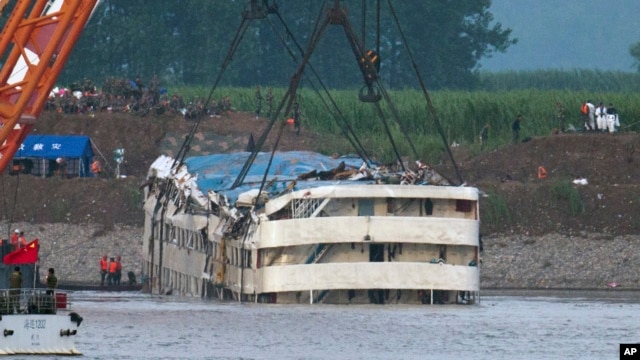
Rescuers watch the capsized ship Eastern Star being lifted by cranes on the Yangtze River in Jianli county of southern China’s Hubei province, as seen from across the river from Huarong county of southern China’s Hunan province, June 5, 2015.
The death toll from in the tour ship capsizing on the Yangtze River rose to 431 Sunday with 11 still missing as recovery teams went through cabins on the vessel.
Disaster teams found hundreds more bodies Friday night and into Saturday morning, with several more discovered Sunday, after pulling the overturned river cruise boat upright with cranes and gradually raising it up from the gray currents of the Yangtze River.
Only 14 people have been rescued since the Eastern Star went down in severe weather late Monday, and authorities had said there was no chance that any of the other 456 people onboard survived. But Hu Kaihong, vice director-general of the press bureau of the State Council Information Office, said authorities were increasing their efforts to search for the missing and had expanded the target area from the middle reaches of the Yangtze more than 1,000 kilometers (600 miles) downstream to Shanghai.
The rescue had been complicated by heavy winds and rain, as well as strong currents that pushed the shallow-draft vessel nearly three kilometers downstream from the spot where it capsized.
Chinese Premier Li Keqiang has been coordinating recovery efforts at the disaster site.
Apology
The operator of the Eastern Star ship made a formal apology Friday to all the victims on board the capsized vessel and paid condolence to their families.
"I am deeply saddened by a tragedy of such a scale," Jiang Zhao, general manager and legal representative of the Chongqing Dongfang Shipping Company that owns the Eastern Star, told an evening press conference in Jianli County of Hubei province.
"I sincerely apologize to the victims and their families, while remaining grateful for the public concerns and widespread attention over this incident. We are also deeply indebted to the search-and-rescue teams from across the country," Jiang said, according to Reuters.
On Saturday night, relatives were taken by bus to an area just upriver of the ship, where they burned incense and tossed flowers into the Yangtze in memory of the dead.
The 77-meter-long vessel overturned Monday evening within minutes of being hit by what Chinese media describe as a tornado. The ship's captain and chief engineer, who survived the sinking, are being questioned by police.
Earlier in the week, transport spokesperson Zhong Shoudao said the ship was designed to navigate inland waterways.
"The river ships tend to have a lower standard on wind resistance and wave resistance than ocean ships,'' Zhong said. "If the force of the blowing wind was more than the ship could withstand, then it would have capsized."
Families unhappy
Beijing had promised an all-out effort to find survivors, but that failed to satisfy many relatives of the missing passengers, who were not happy with a lack of information from authorities.
Scores of family members broke through a police barricade late Wednesday as they marched toward the accident site, demanding information on missing relatives.
Chinese authorities, who have tightly controlled information on the rescue effort, have promised to allow the relatives to visit the site. |
|
